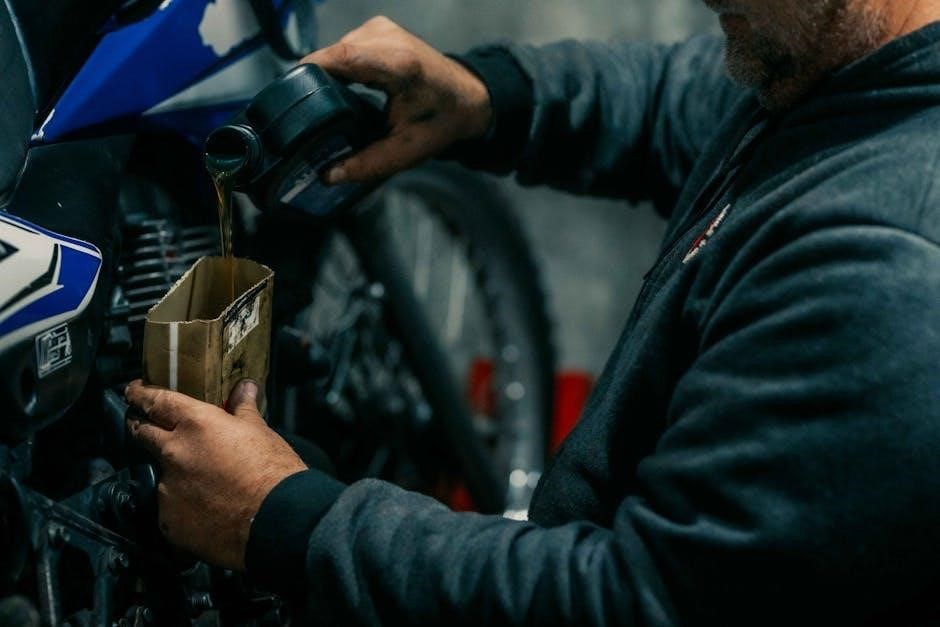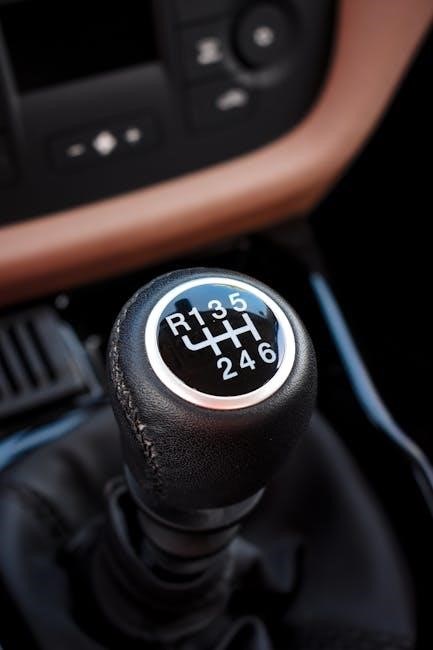The Jeep TJ manual transmission fluid is essential for smooth gear operation and longevity. Proper fluid ensures optimal performance, reduces wear, and prevents overheating. Always use the recommended type and follow maintenance guidelines for best results.
1.1 Overview of the Jeep TJ Transmission System
The Jeep TJ features a robust manual transmission system, including models like the AX-5 and NV-3550. These transmissions rely on specific fluids to ensure smooth gear engagement and durability. The AX-5 typically requires GL-4 75W-90 gear oil, while the NV-3550 often uses ATF or synthetic alternatives. Proper fluid selection is crucial for maintaining optimal performance and preventing premature wear. Regular checks and maintenance are essential to uphold the transmission’s reliability and extend its lifespan.
1.2 Importance of Proper Transmission Fluid
Proper transmission fluid is vital for the Jeep TJ’s manual transmission. It lubricates gears, prevents overheating, and ensures smooth shifting. Using the wrong fluid can lead to reduced performance, increased wear, and potential damage. The fluid also protects against corrosion and maintains the system’s integrity. Regular checks and correct fluid levels ensure optimal functionality, while neglecting this can result in costly repairs. Always refer to the manual for the recommended fluid type to maintain the transmission’s health and longevity.

Types of Manual Transmission Fluid for Jeep TJ
Jeep TJ manual transmissions use ATF (Automatic Transmission Fluid) or gear oil. Synthetic fluids like Redline MTL and GM Synchromesh offer superior performance, while non-synthetic options are more budget-friendly.
2.1 ATF (Automatic Transmission Fluid) vs. Gear Oil
ATF is specifically designed for Jeep TJ manual transmissions, offering smooth shifting and clutch engagement. Gear oil, while similar, is heavier and can cause sluggish performance. Using ATF ensures optimal lubrication and prevents wear on synchronizers and gears. It is crucial to follow the manufacturer’s recommendations to avoid compatibility issues and maintain the transmission’s health. Always check the manual for the correct fluid type to ensure proper functionality and longevity.
2.2 Synthetic vs. Non-Synthetic Fluids
Synthetic fluids, like Redline MTL, offer superior lubrication, better high-temperature performance, and longer change intervals compared to non-synthetic options. Non-synthetic fluids, such as GM Synchromesh, are more affordable and suitable for everyday driving. Synthetic fluids are recommended for extreme conditions or high-performance needs. Both options are viable, but synthetic fluids provide enhanced protection and durability for the Jeep TJ’s manual transmission, ensuring smoother operation and extended component life. Always choose based on your driving habits and manufacturer recommendations.
2.3 Recommended Fluid Viscosity (e.g., 10W-30, 75W-90)
The Jeep TJ manual transmission typically requires a fluid with a viscosity of 75W-90 for optimal performance. This grade provides excellent lubrication and protection across various temperatures. Some sources suggest 10W-30 for specific applications, but 75W-90 is more commonly recommended for its superior high-temperature performance and gear protection. Always verify the correct viscosity for your transmission model, as specified in the manufacturer’s guidelines or technical supplements, to ensure proper function and longevity of the transmission components.

How to Check Manual Transmission Fluid Level
Locate the fill plug on the side of the transmission; Remove it to access the fluid. The level should be just beneath the filler plug opening. Use a metal stem or screwdriver to measure the fluid level accurately. Ensure the fluid reaches the tip without dripping excessively. If low, add the recommended fluid type. Regular checks during oil changes help maintain transmission health and performance.
3.1 Locating the Fill Plug
The fill plug is typically located on the side of the manual transmission, near the axle or midway along the unit. To access it, you may need to use a wrench to remove the plug. The plug’s position varies by transmission type but is usually clearly marked or positioned for easy access. Once removed, the fluid level can be checked by inserting a metal stem or screwdriver into the opening to measure the fluid height. Always ensure the vehicle is on level ground for an accurate reading.
3.2 Determining the Correct Fluid Level
To determine the correct fluid level, insert a metal stem or screwdriver into the fill plug opening. The fluid should reach the bottom of the threads when the plug is tightened. If the fluid level is below this point, add the recommended fluid type until it reaches the correct level. Overfilling can cause damage, so ensure the level is precise. Always check the fluid color and consistency; dark or gritty fluid indicates it may need changing. Consult your manual for specific guidelines.
3.3 Using a Metal Stem or Screwdriver for Measurement
Insert a metal stem or screwdriver into the fill plug opening to measure the fluid level. The fluid should coat the tip of the tool but not drip excessively. If the level is too low, add small amounts of the recommended fluid until it reaches the correct height. Avoid overfilling, as this can damage the transmission. Ensure the tool is clean to avoid contamination. This method provides an accurate way to assess the fluid level without specialized tools.

How to Change Manual Transmission Fluid
Changing manual transmission fluid involves draining the old fluid, refilling with the recommended type, and ensuring proper disposal. Always consult your Jeep TJ manual for specific instructions.
4.1 Tools and Materials Needed
To change the manual transmission fluid, you’ll need a drain pan, socket or wrench for the fill plug, new fluid, a funnel, rags, and safety gloves. Ensure the tools match your transmission type (e.g., AX-5 or NV-3550). Gather all materials beforehand to streamline the process and prevent spills. Proper equipment ensures safety and efficiency during the fluid replacement procedure.
4.2 Step-by-Step Fluid Replacement Process
Start by warming the transmission with a short drive. Locate the fill plug on the side of the transmission. Remove the plug using a socket or wrench. Allow the old fluid to drain completely into a pan. Once drained, replace the fill plug and pour in the recommended fluid using a funnel. Check the fluid level with a metal stem or screwdriver, ensuring it reaches the specified mark. Tighten the plug securely and dispose of the used fluid responsibly.
4.3 Disposal of Used Fluid
After draining the old fluid, carefully pour it into a sealable container. Do not dispose of used transmission fluid down drains or gutters, as it can harm the environment. Take the used fluid to a recycling center or an auto parts store that accepts used fluids. Check local regulations for proper disposal methods. Never mix used transmission fluid with other household waste or fluids. Ensure the container is tightly sealed to prevent leaks during transport.

Recommended Transmission Fluids for Jeep TJ
For optimal performance, use Mopar ATF4, Redline MTL, or GM Synchromesh. These fluids are designed for compatibility and durability in Jeep TJ manual transmissions, ensuring smooth operation;
5.1 Mopar ATF4

Mopar ATF4 is a top choice for Jeep TJ manual transmissions, offering superior performance and compatibility. Designed for both the AX-5 and NV-3550 transmissions, it ensures smooth shifting and protects against wear. This OEM-approved fluid meets Jeep’s specifications, making it a reliable option for maintaining your vehicle’s optimal performance. Its formulation provides excellent lubrication and heat resistance, ensuring long-term durability and reliability in various driving conditions.
5.2 Redline MTL
Redline MTL is a premium synthetic fluid highly recommended for Jeep TJ manual transmissions. It offers excellent lubrication and wear protection, ideal for high-performance driving. Suitable for NV-3550 and NSG 370 units, MTL provides smooth shifting and reduces gear noise. Its high viscosity index ensures consistent performance across temperature ranges, making it a favorite among enthusiasts and for both on-road and off-road use. Redline MTL is a cost-effective, long-lasting choice for maintaining your transmission’s health and reliability.
5.3 GM Synchromesh
GM Synchromesh is a high-quality transmission fluid designed for manual transmissions in Jeep TJ models. It provides excellent wear protection, smooth shifting, and is compatible with synchronizers. Synchromesh is known for its ability to reduce noise and enhance gear engagement, making it a popular choice for drivers seeking reliable performance. While it is synthetic-based, it remains cost-effective and is often recommended for non-synthetic applications, ensuring optimal transmission health without the higher cost of full synthetic fluids. It is a trusted option for maintaining your Jeep TJ’s manual transmission.

Maintenance Tips for Manual Transmission
Regularly check fluid levels using a metal stem or screwdriver. Look for dark color or burnt smell indicating degradation. Change fluid every 100k miles for optimal performance and longevity.
6.1 Frequency of Fluid Changes
For the Jeep TJ, manual transmission fluid changes are typically recommended every 30,000 to 60,000 miles, depending on driving conditions. Severe usage, such as frequent off-roading or towing, may require more frequent changes, around every 15,000 to 30,000 miles. Regular fluid replacement ensures optimal lubrication and prevents premature wear on transmission components, maintaining smooth gear engagement and overall performance.
6.2 Signs of Worn or Degraded Fluid
Signs of worn or degraded manual transmission fluid include a dark or discolored fluid appearance, a burnt smell, or noticeable metallic particles. Difficulty shifting gears, grinding noises, or slipping during acceleration may also indicate degraded fluid. If left unchecked, these issues can lead to premature wear on transmission components. Regularly checking the fluid’s condition and level during oil changes helps identify these signs early, ensuring timely maintenance and preventing costly repairs.
6.3 Checking Fluid During Oil Changes
During oil changes, inspect the manual transmission fluid by locating the fill plug on the transmission’s side. Remove the plug and use a metal stem or screwdriver to check the fluid level. The fluid should be just beneath the cap. Look for changes in color, such as darkening, or a burnt smell, which indicate degradation. Regular checks help detect issues early, ensuring smooth gear operation and preventing costly repairs. Consistent monitoring is crucial for maintaining transmission health and performance.

Technical Service Bulletins and Updates
Jeep issued technical supplements advising the use of 10W-30 oil in manual transmissions for improved performance. Updates also recommend specific fluids for AX-5 and NV-3550 models to ensure compatibility and optimal operation.
7.1 Jeep’s Technical Supplement on 10W-30 Oil
Jeep issued a technical supplement advising the use of 10W-30 oil in manual transmissions for improved performance and compatibility. This recommendation applies to AX-5 and NV-3550 models, ensuring optimal operation. The update emphasizes adhering to manufacturer guidelines to maintain transmission longevity and functionality. Proper fluid selection, as outlined in the supplement, is crucial for preventing wear and overheating, ensuring smooth gear engagement and overall transmission health.
7.2 Manufacturer Recommendations for AX-5 and NV-3550
Jeep specifies that AX-5 transmissions require GL-4 75W-90 gear oil, while NV-3550 models can use GM Synchromesh or ATF4. These fluids ensure proper lubrication and gear engagement. Always follow manufacturer guidelines to maintain optimal performance and prevent damage. Regular checks and adherence to Jeep’s recommendations are essential for extending the life of your manual transmission.

Common Mistakes to Avoid
Using the wrong fluid type, overfilling, or underfilling the transmission can damage components. Always follow the manual’s guidelines for correct fluid selection and filling procedures.
8.1 Using the Wrong Type of Fluid
Using the incorrect fluid, such as gear oil instead of ATF, can lead to poor transmission performance and potential damage. Always select fluid per the manual’s specifications. Redline MTL and GM Synchromesh are popular choices for Jeep TJ transmissions. Avoid substituting with non-recommended fluids, as this can cause worn synchronizers and overheating. Jeep’s technical supplement advises using 10W-30 oil in some cases, but verify compatibility with your specific transmission model. Incorrect fluid use can void warranties or lead to costly repairs, so consult a professional if unsure.
8.2 Overfilling or Underfilling the Transmission
Overfilling or underfilling the transmission can lead to serious issues, such as fluid leakage, increased wear, or overheating. Always use the correct fill procedure and tools to ensure the fluid level is accurate. Locate the fill plug, remove it, and use a metal stem or screwdriver to measure the fluid level. Overfilling can cause fluid to spill onto hot components, while underfilling may result in inadequate lubrication. Refer to your Jeep’s manual or consult a professional to avoid these common mistakes and maintain optimal transmission performance.

DIY vs. Professional Service
DIY transmission fluid changes are cost-effective and manageable for skilled owners, while professional service offers convenience and expertise, though at a higher cost. Choose based on your comfort level and resources.
9.1 Cost Comparison
A DIY transmission fluid change for a Jeep TJ typically costs between $50 and $100, including fluid and basic tools. Professional service can range from $200 to $400, depending on labor rates and location. DIY offers significant savings but requires time and mechanical knowledge. Professional service provides convenience and expertise, especially for those unfamiliar with transmission maintenance. Costs vary based on fluid type, with synthetic options like Redline MTL or GM Synchromesh being more expensive than conventional fluids.
9.2 Time and Difficulty Level
Changing the manual transmission fluid in a Jeep TJ is a moderate DIY task, requiring about 2 to 3 hours for a novice. Basic tools like a socket set, drain pan, and filler pump are needed. The difficulty level is manageable for those with mechanical skills, but novices may find it challenging. Professional service saves time but adds labor costs. Fluid changes are typically needed every 30,000 to 60,000 miles, depending on driving conditions. Always check the fluid’s condition during oil changes to determine if a change is necessary.
Regular maintenance with the correct manual transmission fluid ensures optimal performance, reduces wear, and extends the life of your Jeep TJ’s transmission. Always follow recommendations for best results.
10.1 Summary of Key Points
Proper manual transmission fluid is crucial for Jeep TJ performance and longevity. Use ATF or gear oil as recommended, with synthetic options offering superior durability. Regular fluid checks and changes, every 30,000 to 100,000 miles, prevent wear and overheating. Recommended fluids include Mopar ATF4, Redline MTL, and GM Synchromesh. Always adhere to viscosity specifications like 75W-90 for optimal gear function. Follow manufacturer guidelines for AX-5 and NV-3550 transmissions to ensure reliability and avoid costly repairs.
10.2 Final Tips for Maintaining Your Jeep TJ’s Manual Transmission
Always refer to your Jeep TJ manual for fluid recommendations. Check transmission fluid levels regularly using a metal stem or screwdriver. Avoid using the wrong fluid type, as it can damage gears. Never overfill, as this can cause pressure issues. Change fluid every 30,000 to 100,000 miles for optimal performance. Use synthetic fluids like Redline MTL or Mopar ATF4 for improved durability. Address any signs of worn fluid, such as dark color or burnt smell, promptly to prevent damage.
